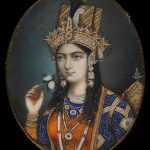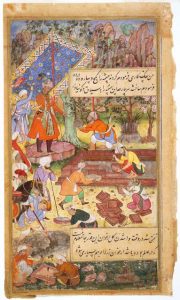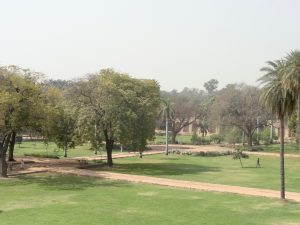The Taj Mahal is many things. It’s a seventeenth century mausoleum built by Shah Jahan for his favorite wife Mumtaz Mahal. As such, it’s often called a monument to love.
Mumtaz Mahal Begum (Exalted One of the Palace) was the Shah’s second wife, and chief consort. She died giving birth to her fourteenth child. Shah Jahan built the Taj Mahal as a monument to her.
 The Taj Mahal is also an outstanding example of Mughal architecture attracting over eight million visitors annually. In their eagerness to reach the monument and take pictures, visitors often walk through the gardens without realizing that they are as much a part of the monument as the white marble.
The Taj Mahal is also an outstanding example of Mughal architecture attracting over eight million visitors annually. In their eagerness to reach the monument and take pictures, visitors often walk through the gardens without realizing that they are as much a part of the monument as the white marble.
PERSIAN & ISLAMIC GARDENS of PARADISE
 The garden architecture that once surrounded the Taj Mahal began with the gardens Cyrus the Great built at his palace complex at Pasargadai. These were conceived to represent the four Zoroastrian elements of sky, earth, water, and plants. The gardens were Paradise, a word that entered European languages from the Persian root word, Pardi.
The garden architecture that once surrounded the Taj Mahal began with the gardens Cyrus the Great built at his palace complex at Pasargadai. These were conceived to represent the four Zoroastrian elements of sky, earth, water, and plants. The gardens were Paradise, a word that entered European languages from the Persian root word, Pardi.
The one garden is divided into four sections called the Chahār Bāgh. Other characteristics are a high surrounding wall, straight channels of water, bubbling fountains, trees for shade and fruit, and flowers. Islamic designers saw the gardens as emulating the Garden of Eden with four rivers and four quadrants representing the world.
 These elements can still be seen in the Gardens of the Alhambra which was converted to a Moorish palace by the Sultan of Granada in 1333. Moorish designers planned a garden with roses, oranges, and myrtles as well as water features. The Palacio de Gereralife (Architect’s Garden) includes the Patio de la Acequia, or Court of the Water Channel, a long pool framed by flowerbeds and decorated with fountains and pavilions.
These elements can still be seen in the Gardens of the Alhambra which was converted to a Moorish palace by the Sultan of Granada in 1333. Moorish designers planned a garden with roses, oranges, and myrtles as well as water features. The Palacio de Gereralife (Architect’s Garden) includes the Patio de la Acequia, or Court of the Water Channel, a long pool framed by flowerbeds and decorated with fountains and pavilions.
The most important features of Islamic gardens were running water and a pool to reflect the sky, trees for fruit and shade, flowers for color and fragrance, birds to fill the garden with song, and pleasant breezes.
MOGHUL GARDENS
 Babur, the first Mughal emperor brought Islamic gardens to the Indian sub-content as he established his empire in the sixteenth century. The first important Islamic garden in India, still visited by tourists today, is Humayun’s Tomb. Humayun was Babur’s son. After his death in 1556, his chief consort Empress Bega Begum dedicated herself to building an appropriate memorial. Completed in 1572, it was the first Chahār Bāgh Garden in India.
Babur, the first Mughal emperor brought Islamic gardens to the Indian sub-content as he established his empire in the sixteenth century. The first important Islamic garden in India, still visited by tourists today, is Humayun’s Tomb. Humayun was Babur’s son. After his death in 1556, his chief consort Empress Bega Begum dedicated herself to building an appropriate memorial. Completed in 1572, it was the first Chahār Bāgh Garden in India.
 The tomb stands in the center of a thirty acre Chahār Bāgh. The enclosed garden is divided by walkways and two bisecting central water channels to depicted the four rivers of Paradise. Each square is subdivided into smaller squares. These gardens and their tomb became a precursor for Shah Jahan’s design of the Taj Mahal.
The tomb stands in the center of a thirty acre Chahār Bāgh. The enclosed garden is divided by walkways and two bisecting central water channels to depicted the four rivers of Paradise. Each square is subdivided into smaller squares. These gardens and their tomb became a precursor for Shah Jahan’s design of the Taj Mahal.
TAJ MAHAL

 The design for the Taj Mahal and its gardens encompasses the Yamuna River which flows behind the tomb, with a Moonlit Garden (Mahtab Bagh) on the opposite side of the river. With the inclusion of the Moonlit Garden, the Taj Mahal is in the traditional center of the garden. The picture below is the Taj Mahal from across the Yamuna River.
The design for the Taj Mahal and its gardens encompasses the Yamuna River which flows behind the tomb, with a Moonlit Garden (Mahtab Bagh) on the opposite side of the river. With the inclusion of the Moonlit Garden, the Taj Mahal is in the traditional center of the garden. The picture below is the Taj Mahal from across the Yamuna River.
The formal layout has raised pathways divided into four quarters each of which was subdivided to form sixteen flowerbeds. The garden had four hundred plants including Cyprus trees symbolizing death and fruit trees representing life. Favorite trees were mango, lemon, and pomegranate. Early accounts describe roses, daffodils, hibiscus, and jasmine flowers.
???
Illustrations:
Opening Photo of Taj Mahal by Author.
Mumtaz Mahal (1820 rendering). Public Domain. Wikimedia Commons.
Cyrus the Great Relief at entrance to Pasargadae by Siamax. Creative Commons Attribution. Wikimedia Commons.
Patio de la Acequia at the Alhambra by Andrew Dunn. Creative Commons Attribution. Wikimedia Commons.
Babur supervising creation of a garden. Public Domain. Wikimedia Gardens.
Grounds at Humayun’s Tomb. Photo by Author.
Taj Mahal. 1890. Public Domain. Wikimedia Commons.
Eighteenth century rendering of Taj Mahal with Moonlit Gardens. Public Domain. Wikimedia Commons.
Taj Mahal from across the Yamuna River. Photo by Author.
The Persian Garden. World Heritage List.
K. E. Eduljee. Persian Gardens. Heritage Institute.

Sandra Wagner-Wright holds the doctoral degree in history and taught women’s and global history at the University of Hawai`i. Sandra travels for her research, most recently to Salem, Massachusetts, the setting of her new Salem Stories series. She also enjoys traveling for new experiences. Recent trips include Antarctica and a river cruise on the Rhine from Amsterdam to Basel.
Sandra particularly likes writing about strong women who make a difference. She lives in Hilo, Hawai`i with her family and writes a blog relating to history, travel, and the idiosyncrasies of life.




Beautiful Sandra, thank you for sharing! Keep us posted on ‘Two Coins!’ ox
You can be sure everyone will know when Two Coins is ready to launch. Mahalo for asking.